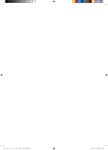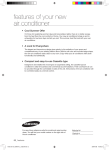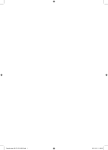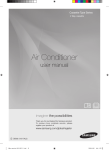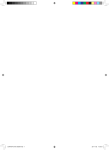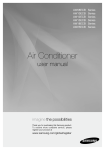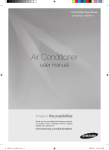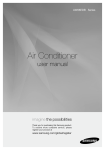Download Samsung FC24ETVA User Manual
Transcript
features of your new air conditioner • Cool Summer Offer On those hot sweltering summer days and long restless nights, there is no better escape from the heat than the cool comforts of home. Your new air conditioner brings an end to exhausting hot summer days and lets you rest. This summer, beat the heat with your own air conditioner. • Cost Efficient System Your new air conditioner not only provides maximum cooling power in the summer, but can also be an efficient heating method in the winter with the advanced “Heat pump” system. This technology is up to 300% more efficient than electrical heating, so you can further reduce its running cost. Now, meet year-round needs with one air conditioner. • A Look for Everywhere The elegant and harmonious design gives priority to the esthetics of your space and complements any of your existing interior décor. With its soft color and rounded-edge shape, the new air conditioner adds class to any room. Enjoy what your air conditioner offers both functionally and esthetically. • Flexible Installation Your new air conditioner has couple of installation options. It can be installed on the floor just like other ordinary floor type air conditioner and also can be installed under the ceiling to provide cool and warm air from above. 6 different drain pipe options will also give you more flexible installation options. Have your air conditioner installed wherever you want to. For easy future reference write the model and serial number down. You will find your model number on the right side of the air conditioner. 02_ features Model # Serial # safety information To prevent electric shock, disconnect the power before servicing, cleaning, and installing the unit. SAFETY INFORMATION Before using your new air conditioner, please read this manual thoroughly to ensure that you know how to safely and efficiently operate the extensive features and functions of your new appliance. What the icons and signs in this user manual mean: WARNING CAUTION CAUTION Risk of death or serious personal injury. Potential risk of personal injury or material damage. To reduce the risk of fire, explosion, electric shock, or personal injury when using your air conditioner, follow these basic safety instructions: Do NOT attempt. Do NOT disassemble. Do NOT touch. Follow directions carefully. Unplug the power plug from the wall socket. Make sure the machine is grounded to prevent electric shock. Call the contact center for help. Recommended instructions or useful information for use. These warning signs are here to prevent injury to you and others. Please follow them carefully. After reading this section, keep it in a safe place for future reference. SEVERE WARNING SIGNS Do not cut the power plug and connect to a different power cable. Never attempt to lengthen the power cable. • Potential risk of fire or electric shock. Do not yank the power cable and touch the power plug with wet hands. • Potential risk of fire or electric shock. Never use a damaged power plug, power cable, or loosened power receptacle. • Potential risk of fire or electric shock. safety information _03 ENGLISH Because the following operating instructions cover various models, the characteristics of your air conditioner may differ slightly from those described in this manual. If you have questions, call your nearest contact center or find help and information online at www.samsung.com. safety information SEVERE WARNING SIGNS Do not place the air conditioner near hazardous substances or equipment that releases free flames to avoid fires, explosions or injuries. • Potential risk of fire hazard or explosion. Do not spray flammable gases such as insecticide near the air conditioner. • Potential risk of electric shock, fire or unit malfunction. Do not block or place items in front of the air conditioner. Do not step, hang onto, or place heavy items on the air conditioner. • Potential risk of personal injury. Do not insert anything such as fingers or branches into the air conditioner vents. • Keep children away from the air conditioner. Potential risk of personal injury. Do not install the air conditioner in areas exposed to the inflammable gas leakage or the potential risk of gas leakage. • Potential risk of fire hazard or explosion. Do not install the outdoor unit at an unstable place such as outer high wall of an apartment or building and on a outside of terrace to avoid falling. • If the outdoor unit falls, it may cause personal injury or loss of property. Consult the place of purchase or a contact center to disassemble or reinstall the air conditioner. • Potential risk of unit malfunction, water leakage, electric shock, or fire. Do not connect the air conditioner with heating apparatus or do not attempt to disassemble, remodel or repair it by yourself. • Potential risk of malfunction, electric shock or fire. If repairs are needed, consult the contact center. Consult the place of purchase or a contact center to install the air conditioner. • Improper installation carries a risk of unit malfunction, water leakage, electric shock or fire. • If installing in specialty areas, such as a factory complex or saline coastal area, consult the place of purchase or contact center for specific installation details. Install the air conditioner with the support bracket securely fastened to use for an extended period of time. • If the air conditioner falls, it may cause personal injury or loss of property. Ensure the air conditioner is installed in compliance with current national safety standards. Use a rated circuit breaker only. • Never use steel wires or copper wires as a circuit breaker. It may cause fire or unit malfunction. Use an exclusive power source for the air conditioner. • Potential risk of electric shock or fire. Do not put undue stress on the power cable or place heavy objects on it. Do not bend the power cable excessively. • Potential risk of fire or electric shock. 04_ safety information If the air conditioner becomes wet, turn the power off immediately and call your nearest contact center. • Potential risk of fire or electric shock. Install an exclusive circuit breaker and short-circuit breaker for the air conditioner. • Potential risk of electric shock or fire. • Improper electrical grounding may cause electric shock or fire. Ensure proper ground has been established when installing the air conditioner. Do not connect the ground cable of the unit to a gas pipe, a water pipe or a telephone line. • Potential risk of electric shock. CAUTION SIGNS Ensure no water gets into the air conditioner. • Potential risk of fire or electric shock. Do not install the air conditioner close to heating appliances to avoid damage. Turn off the air conditioner using the provided remote control or control accessory (if provided). Do not unplug to turn off the unit (unless there is an immediate danger). Do not open the front grille during operation. • Potential risk of electric shock or unit malfunction. Cool air should not flow directly towards people, pets, and plants. • It is harmful to your health, pets, and plants. Do not run the air conditioner for an extended period of time in a room with the door closed or with babies, elderly or disabled people. • Open the door or windows to ventilate your room at least once an hour to prevent oxygen shortage. Do not use the air conditioner as a cooling precision instrument for food, pets, plants, cosmetics or machinery. • Potential risk of property loss. Do not drink water from the air conditioner. • Potential risk of health hazard. Do not give excessive shock to the air conditioner. • Potential risk of fire or unit malfunction. Do not expose the dust filter to direct sunlight while drying. • Strong direct sunlight may deform the dust filter. Do not spray water directly on the air conditioner or use benzene, thinner or alcohol to clean the surface of the unit. • Potential risk of electric shock or fire. • Potential risk of damage to the air conditioner. safety information _05 ENGLISH If the power cable or cord is damaged, the manufacturer, a qualified service technician must replace it to avoid a potential risk. Disconnect the air conditioner from power supply before it is repaired or disassembled. Use a receptacle that has a ground terminal. The receptacle must be used exclusively for the air conditioner. safety information CAUTION SIGNS Do not place containers with liquid or other objects on the unit. Do not pull the indoor unit. • If the indoor unit falls, it may cause personal injury. Do not allow children to climb on the air conditioner. Do not touch the pipe connected to the air conditioner. • Potential risk of personal injury or burn. The air conditioner is composed of moving parts. Keep children away from the unit to avoid physical injury. Check for damage on delivery. If damaged, do not install the air conditioner and call the place of purchase immediately. Make sure the voltage and frequency of the electric system are compatible with the air conditioner. Insert the dust filter before operating the air conditioner. • If there is no dust filter inside the air conditioner, accumulated dust may shorten the life of the air conditioner and cause electricity waste. Keep indoor temperatures stable and not extremely cold, especially where there are children, elderly or disabled people. Clean the conditioner after the inner fan stops operating. • Potential risk of injury or electric shock. Clean the filter more frequently if the air conditioner is operated in dusty areas. Inspect the condition, electric connections, pipes and external case of the air conditioner regularly by a qualified service technician. Do not open doors and windows in the room being cooled during operation unless necessary. Do not block air conditioner vents. If objects block the air flow, it may cause unit malfunction or poor performance. The packaging material and used batteries of the remote control(optional) must be disposed of in accordance with the national standards. The refrigerant used in the air conditioner must be treated as chemical waste. Dispose the refrigerant following national standards. Have a qualified service technician install the air conditioner and perform a trial operation. Install the air conditioner away from direct exposure to sunlight, heating apparatus, and humid places. • Hang a curtain to boost cooling efficiency and to avoid the risk of electric shock. Firmly connect the drain hose to the air conditioner for a proper water drainage. • If it is not drain well, the condensed-water from the indoor unit may overflow and leak into the room. Install the outdoor unit where operating noise and vibration will not disturb your neighbor and be well-ventilated with no obstacle. • Potential risk of malfunction. • Operating noise may disturb your neighbor. 06_ safety information Install the shortest possible length of pipe. • If the length of pipe is long, the air conditioner life can be shorten and become inefficient. If a power outage occurs while the air conditioner is working, turn off the power source immediately. When cleaning the outdoor unit, touch the heat exchanger radiator fins with extreme care. • Wearing thick gloves can protect your hands. Make sure there are no obstacles under the indoor unit. Make sure that children take precautions against access to the air conditioner and they do not play with the unit. The maximum input power & current and the input power & current are measured in accordance with the rules given in the IEC/ISO. Ensure to use the wireless remote control up to a distance of about 7m from the remote control sensor of the air conditioner. • The air conditioner may not work over the distance of 7m. Make sure the cover or any obstacle is not near the air conditioner. Allow sufficient space for air circulation. • Insufficient ventilation may result in poor performance. Batteries should be removed from the wireless remote control and be kept separate when unused for long period of time. If failure or damage occurs on the conditions of improper use not followed by the installation manual, there will be an extra labor charge for installing and construction. • Potential risk of malfunction, electric shock or fire if repairs or installations are attempted by a non-qualified service technician. Ensure the off-on and protection switches are properly installed. Do not use the air conditioner if damaged. If problems occur, immediately stop operation and disconnect the plug from the power supply. If the air conditioner will not be used for an extended period of time (for example, over several months), unplug the power from the wall. Call the place of purchase or a contact center if repairs are needed • Potential risk of fire or electric shock if disassembly or repairs are attempted by a non-qualified service technician. If you smell burning plastic, hear strange sounds, or see smoke coming from the unit, unplug the air conditioner immediately and call a contact center. • Potential risk of fire or electric shock. The supply cord used in the installation should be H05RN-F minimum , the size of the cord should be 1,5mm² minimum The interconnection cord in the installation should be H05RN-F minimum , the size of the cord should be 0,75mm² minimum safety information _07 ENGLISH • Potential risk of fire or loss of property. contents SETTING UP YOUR AIR CONDITIONER BEFORE USE 09 09 Getting ready to set up the air conditioner Selecting the best location VIEWING YOUR AIR CONDITIONER 10 Checking the part USING YOUR AIR CONDITIONER 11 12 12 Tips on using air conditioner Adjusting the air flow direction Horizontal air flow CLEANING AND MAINTAINING THE AIR CONDITIONER 13 13 15 15 16 Cleaning the exterior Cleaning the filter Maintaining your air conditioner Periodical checks Internal protections via the unit control system APPENDIX 17 18 19 Troubleshooting Operation ranges Memo 09 10 11 13 17 08_ contents setting up your air conditioner before use GETTING READY TO SET UP THE AIR CONDITIONER First select a location to set up the air conditioner. Selecting the best location You may set up your air conditioner under the ceiling or on the floor depending on your installation environment. Consider interior design, available space and the origin of cool or warm air to select the best location. On the floor Under the ceiling setting up your air conditioner before use _09 ENGLISH Congratulations on the purchase of the air conditioner. We hope you will enjoy the features of your air conditioner and stay cool or warm with optimal efficiency. Please read the user manual to get started and to make the best use of the air conditioner. viewing your air conditioner Now that you have your new air conditioner set up, you are ready to enjoy the full features and functions of the appliance. Be sure to know about each part of your new air conditioner before use. CHECKING THE PART Main parts Air flow blade(up/down) Air flow blade(right/left) Air filter(inside) Front grille display Remote control sensor Defrosting indicator (Except cooling only models) Filter sign indicator Fan indicator Timer indicator Auto mode indicator Operation indicator Power button Your air conditioner and display may look slightly different from the illustration shown above depending on your model. 10_viewing your air conditioner using your air conditioner TIPS ON USING AIR CONDITIONER Here are some tips that you would follow when using your air conditioner. RECOMMENDATION Cooling • If current outside temperatures are much higher than the selected indoor temperature, it may take time to bring the inner temperature to the desired coolness. • Avoid drastically turning down the temperature. Energy is wasted and the room does not cool faster. Heating • Since the air conditioner heats the room by taking heat energy from outdoor air, the heating capacity may decrease when outdoor temperatures are extremely low. If you feel the air conditioner insufficiently heats, using an additional heating appliance in combination with the air conditioner is recommended. Frost & De-ice • When the air conditioner runs in Heat mode, due to temperature difference between the unit and the outside air, frost will form. If this happens: - The air conditioner stops heating. - The air conditioner will operate automatically in De-ice mode for 10 minutes. - The steam produced on the outdoor unit in De-ice mode is safe. No intervention is required; after about 10 minutes, the air conditioner operates again normally. The unit will not operate when it starts to de-ice. Fan • Fan may not operate for about 3~5 minutes at the beginning to prevent any cold blasts while the air conditioner is warming up. High indoor/outdoor temperatures • If both indoor and outdoor temperatures are high and the air conditioner is running in Heat mode, the outdoor unit’s fan and compressor may stop at times. This is normal; wait until the air conditioner turns on again. Power failure • If a power failure occurs during the operation of the air conditioner, the operating immediately stops and unit will be off. When power returns, the air conditioner will run automatically. Protection mechanism • If the air conditioner has just been turned on after operation stops or being plugged in, cool/warm air does not come out for 3 minutes to protect the compressor of the outdoor unit. using your air conditioner _11 ENGLISH TOPIC using your air conditioner ADJUSTING THE AIR FLOW DIRECTION Air flow can be directed to your desired position. Horizontal air flow You may set up your air conditioner under the ceiling or on the floor depending on your installation environment 1. Move the each set of inner air flow blades left or right to keep the air flow direction in a constant position you prefer. CAUTION Be extremely careful with your fingers while adjusting the Horizontal air flow direction. There is a potential risk of personal injury when the unit is mishandled. PUS H PUS H 12_ using your air conditioner cleaning and maintaining the air conditioner For the best performance from your air conditioner, clean it periodically. When cleaning, make sure to unplug from the unit for user’s safety. When cleaning the exterior, make sure to unplug the power from the unit. No special tools are needed to clean it. 1. Wipe the surface of the unit with a slightly wet or dry cloth when needed. Wipe off dirt of odd-shaped area by using a soft brush. CAUTION Do not use Benzene or Thinner. They may damage the surface of the air conditioner and can create a risk of fire. CLEANING THE FILTER When cleaning the grille, make sure to unplug the power from the unit. No special tools are needed to clean it. 1. Open the front grille. Push the [PUSH] tabs located in 3 places to unlock the groove on the front grille. PUS H 2. Detach the front grille. Hold the front grille at about 45˚ angle. Push the bottom part of the grille to make sure it is unhooked. Then, lift up the front grille. PUS H PU SH cleaning and maintaining the air conditioner _13 ENGLISH CLEANING THE EXTERIOR cleaning and maintaining the air conditioner CLEANING THE FILTER 3. Pull out the Air filter. Slightly press the air filter and then pull the air filter out. 4. Clean the Air filter with a vacuum cleaner or soft brush. If dust is too heavy, then rinse it with running water and dry it in a ventilated area. 5. Insert the Air filter back in its original position. 6. Close the front grille. • After cleaning the filter, press the Filter Reset button on the remote control for 2 seconds to reset the filter schedule. • For best conditions, repeat every two weeks. • If the Air filter dries in a confined (or humid) area, odors may generate. If it occurs, re-clean and dry it in a well-ventilated area. 14_cleaning and maintaining the air conditioner MAINTAINING YOUR AIR CONDITIONER If the air conditioner will not be used for an extended period of time, dry the air conditioner to maintain it in best condition. 1. Dry the air conditioner thoroughly by operating in Fan mode for 3 to 4 hours and disconnect the power plug. There may be internal damage if moisture is left in components. Periodical checks Refer to the following chart to maintain the air conditioner properly. Type Description Clean the air filter (1) Indoor unit Monthly Every 4 months Clean the condensate drain pan (2) Thoroughly clean the heat exchanger (2) Clean the condensate drain pipe (2) Replace the remote control batteries (1) Clean the heat exchanger on the outside of the unit (2) Outdoor unit Once a year Clean the heat exchanger on the inside of the unit (2) Clean the electric components with jets of air (2) Verify that all the electric components are firmly tightened (2) Clean the fan (2) Verify that all the fan assembly is firmly tightened (2) Clean the condensate drain pan (2) The checks and maintenance operations described are essential to guarantee the efficiency of the air conditioner. The frequency of these operations varies according to the characteristics of the area, the amount of dust, etc. (1) The described operations should be performed more frequently if the area of installation is very dusty. (2) These operations must always be performed by qualified personnel. For more detailed information, see the Installation Manual. cleaning and maintaining the air conditioner _15 ENGLISH 2. Before using the air conditioner again, dry the inner components of the air conditioner again by running in Fan mode for 3 to 4 hours. This helps remove odors which may have generated from dampness. cleaning and maintaining the air conditioner MAINTAINING YOUR AIR CONDITIONER Internal protections via the unit control system This internal protection operates if an internal fault occurs in the air conditioner. Type Description Against cold air The internal fan will be off to against cold air when the heat pump is heating. De-ice cycle The internal fan will be off to against cold air when the heat pump is heating. Anti-protection of internal battery Protect compressor The compressor will be off to protect internal battery when the air conditioner operates in Cool mode. The air conditioner does not start operating immediately to protect the compressor of the outdoor unit after it has been started. If the heat pump is operating in Heat mode, De-ice cycle is actuated to remove frost from an outdoor unit that may have deposited at low temperatures. The internal fan is switched off automatically and restarted only after the de-ice cycle is completed. 16_cleaning and maintaining the air conditioner appendix TROUBLESHOOTING Refer to the following chart if the air conditioner operates abnormally. This may save time and unnecessary expenses. SOLUTION The air conditioner does not operate immediately after it has been restarted. • Because of the protective mechanism, the appliance does not start operating immediately to keep the unit from overloading. The air conditioner will start in 3 minutes. The air conditioner does not work at all. • Check that the power plug is properly connected. Insert the power plug into the wall socket correctly. • Check if the circuit breaker is switched off. • Check if there is a power failure. • Check your fuse. Make sure it is not blown out. The temperature does not change. • Check if you selected Fan mode. Press the Mode button on the remote control to select another mode. The cool (warm) air does not come out of the air conditioner. • Check if the set temperature is higher (lower) than the current temperature. Press the Temperature button on the remote control to change the set temperature. Press the Temperature button to decrease or increase the temperature. • Check if the air filter is blocked by dirt. Clean the air filter every two weeks. • Check if the air conditioner has just been turned on. If so, wait 3 minutes. Cool air does not come out to protect the compressor of the outdoor unit. • Check if the air conditioner is installed in a place with a direct exposure to sunlight. Hang curtains on windows to boost cooling efficiency. • Check if the cover or any obstacle is not near the outdoor unit. • Check if the refrigerant pipe is too long. • Check if the air conditioner is only available in Cool mode. • Check if the remote control is only available for cooling model. The fan speed does not change. • Check if you selected Auto or Dry mode. The air conditioner automatically adjusts the fan speed to Auto in Auto/Dry mode. Timer function does not set. • Check if you press the Power button on the remote control after you have set the time. Odors permeate in the room during operation. • Check if the appliance is running in a smoky area or if there is a smell entering from outside. Operate the air conditioner in Fan mode or open the windows to air out the room. The air conditioner makes a bubbling sound. • A bubbling sound may be heard when the refrigerant is circulating through the compressor. Let the air conditioner operate in a selected mode. • When you press the Power button on the remote control, noise may be heard from the drain pump inside the air conditioner. Water is dripping from the air flow blades. • Check if the air conditioner has been cooling for an extended period of time with the air flow blades pointed downwards. Condensation may generate due to the difference in temperature. Remote control is not working. • • • • The air conditioner does not turn on or off with the wired remote control. • Check if you set the wired remote control for group control. The wired remote control does not operate. • Check if TEST indicator is displayed on the wired remote control. If so, turn off the unit and switch off the circuit breaker. Call your nearest contact center. The indicators of the digital display flashes. • Press the Power button on the remote control to turn the unit off and switch the circuit breaker off. Then, switch it on again. Check if your batteries are depleted. Make sure batteries are correctly installed. Make sure nothing is blocking your remote control sensor. Check that there are strong lighting apparatus near the air conditioner. Strong light which comes from fluorescent bulbs or neon signs may interrupt the electric waves. appendix _17 ENGLISH PROBLEM appendix OPERATION RANGES The table below indicates the temperature and humidity ranges the air conditioner can be operated within. Refer to the table for efficient use. MODE OPERATIONAL TEMPERATURE INDOOR OUTDOOR INDOOR HUMIDITY COOLING 21˚C to 32˚C 21˚C to 54˚C 80% or less DRYING 21˚C to 32˚C 21˚C to 54˚C - IF OUT OF CONDITIONS Condensation may occur on the indoor unit with risk to have either water blow off or drops on the floor. Condensation may occur on the indoor unit with risk to have either water blow off or drops on the floor. If the cooling operation is used at over 32˚C (indoor temperature), it does not cool at its full capacity. 18_ appendix Memo ENGLISH appendix _19 QUESTIONS OR COMMENTS? COUNTRY CALL OR VISIT US ONLINE AT MALAYSIA 1800-88-9999 www.samsung.com/my Turkey 444 77 11 www.samsung.com/tr SOUTH AFRICA 0860-SAMSUNG(726-7864 ) www.samsung.com/za U.A.E 800-SAMSUNG (726-7864) 8000-4726 www.samsung.com/ae Convertible Type Series Ceiling/Floor series Air Conditioner user manual imagine the possibilities Thank you for purchasing this Samsung product. To receive more complete service, please register your product at www.samsung.com/global/register E A DB98-27861A (1)























